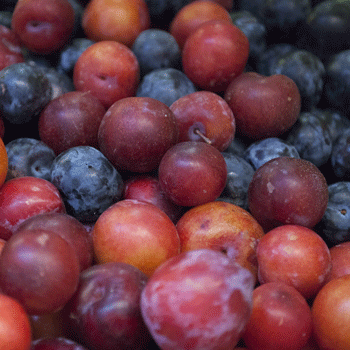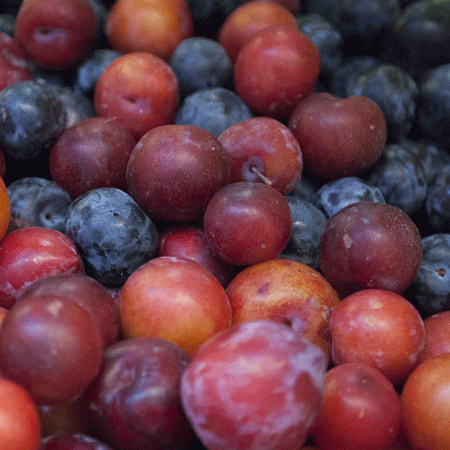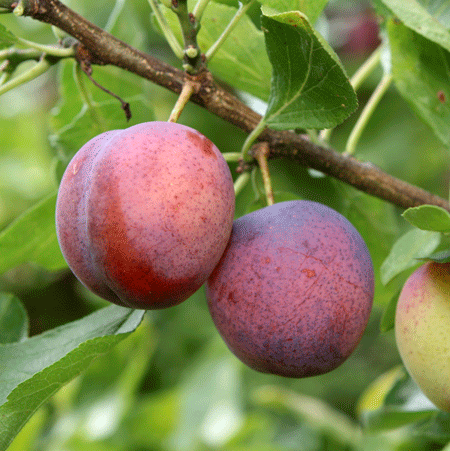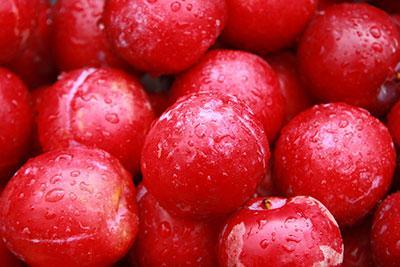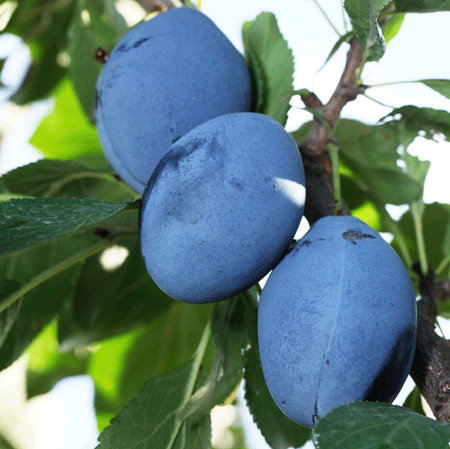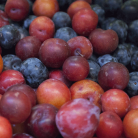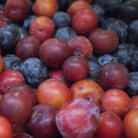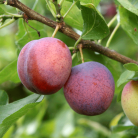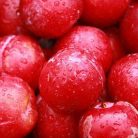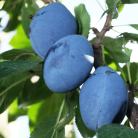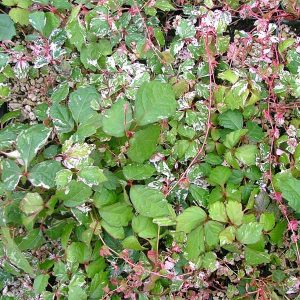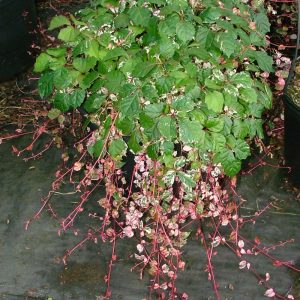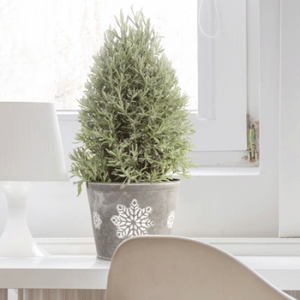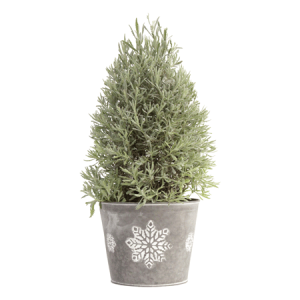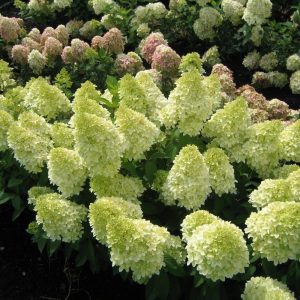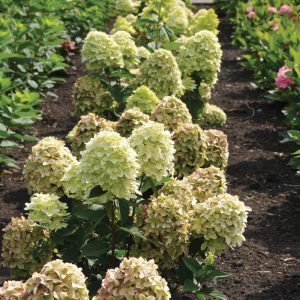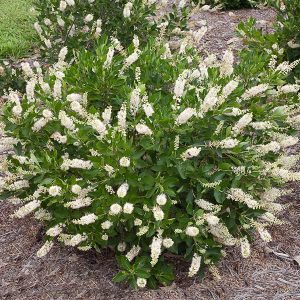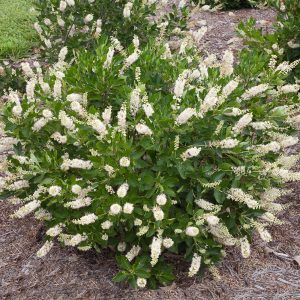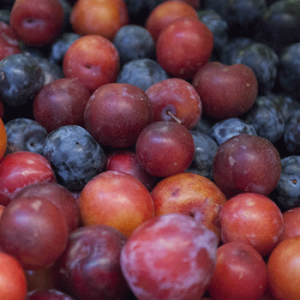4-in-1 Plum Surprise Discount
- Estimated Delivery : Up to 4 business days
- Free Shipping & Returns : On all orders over $200
4 Plum Varieties on 1 Tree
If you like plums, you’ll LOVE our 4-in-1 plum trees. You’ll get 4 different types of juicy plums from just one tree. You won’t need a lot of yard space to enjoy a large harvest year after year. We’ve selected 10 different varieties of plum trees that thrive when hand grafted together; no matter which combination of 3 types of plums are grouped on your tree.
The fun part is, you won’t know which four types of plums were grafted onto your tree until it produces fruit – so your first harvest will be a sweet surprise!
Get Fruit the Very First Season
Your 4-in-1 Plum Tree is hand grafted, which means the top of a mature tree is spliced onto the root-stock of a young new tree. This process safely speeds up the growth of the tree, because it “tricks” the tree into thinking it’s more mature.
Pick Plums Over a Longer Harvest Period
Hand grafting takes a considerable amount of time and effort on our end, and we nurture the tree for years before we ship it to you. You won’t wait up to 5 years for your tree to bear fruit. Since your tree thinks that it’s older, you should have fruit the first season you plant your tree.
Since your tree is self-pollinating, you won’t need pollinating partner trees, just plant one tree and watch it grow and produce a plethora of delicious plums in 3 different varieties.
Plum Trees are Easy to Grow
Plum trees are resilient and thrive in most conditions; doing best in water-retentive soils and mulch. While areas in the south are ideal for plums, these trees are bred to be quite hardy in colder climates. That means they can often find a home in the north (if springtime isn’t riddled with too many frost advisories.)
The best planting times are mid-to-late March through April, as this will provide the tree adequate time to grow strong roots before facing summer heat. Your tree will flower in early spring and you can expect your plums to be ready to pick during the summer months.
How to Know When Your Plums Are Ripe.
If you’re looking for optimal flavor, it’s best to let your plums ripen on the tree. Knowing when to pick plums is rather easy. Gently squeeze the skin of the plum and if it feels soft then it can be picked by using only a slight twist.
When you pick ripe plums from the tree, they’ll keep well for 2 to 4 weeks when stored in a refrigerator.
If you should need to pick your plums before they ripen on the vine, you can. Simply store them in a brown paper bag or a location that’s between 66 and 75°F until they’re ready.
Popular Uses for Plums
If you’re a smoothie enthusiast, plums are a nourishing and flavorful addition to your healthy concoction. Or simply mix with apple juice, for a lip-smacking, refreshing beverage.
It’s hard to imagine an “overabundance” of plums when you love them so much. But they will come in with vigor and you’ll have a lot of them. They’re so enjoyable right off the tree, and they’re just as flavorful when you prepare them for use throughout the year. You can make jams, jellies and even wine.
There are endless recipes that include plums, including the obvious: pies, breads and cakes. Plums also add a distinctive flavor to sauces and deductions. (Sauces that includes plums are paired nicely with pork dishes!)
Plums Provide All Natural Benefits
Your 3-in-1 plum tree will be all natural with no GMOs or dangerous chemicals.
Plums are a nutritional way to enjoy snacking while fueling your body with energy. They’re loaded with Vitamins C, K and A (beta-carotene.) Plums also contain antioxidants which have been linked to lowering the risks of cancer.
Make your own plum juice instead of buying expensive store-bought laxatives. This can be a natural and convenient home remedy for constipation.
3-in-1 Plum Trees For Sale – Order Yours Now! If you’re seeking a mouth-watering fruit tree that requires little care, this hardy option will make a lovely addition to your home. Not only is it beautiful, but it provides a trouble-free harvest of four plums on a single tree.
If you’re ready for the mysterious adventure of a 3-in-1 plum tree, simply order today.
Planting & Care
A unique addition to your landscape, the multi graft plum (Prunus sp.) tree will provide you with loads of multiple varieties of plums with only one tree. Only reaching 15-20 feet tall and 15 feet wide it is compact enough for a small yard and the fruit is more easily harvested. Growing in zones 5-9, the tree is cold tolerant down to -10 degrees and requires approximately 600 chill hours (depending on the variety of plum), so most varieties will produce, even in warmer climates. This tree provides several months of interest also as it blooms in early spring, produces fruit in mid to late summer, and has excellent fall color. Multi graft trees are self fertile so you only need the one tree for fruit!
Choosing a location: All plum trees need a full sun exposure location so be sure to pick a bright spot for the trees new home. Well draining, sandy soil is highly recommended with a pH range from 5.5 to 6.5 (which can be easily determined with an inexpensive soil testing kit from your local nursery big box store). If possible, plant the tree in a South or West location to cut back on the wind which in turn will assist the tree in setting fruit.
Planting directions:
1) Prepare your hole by digging it three times as wide as the root ball and just as deeply.
2) Gently comb the root ball freeing up any compacted roots and place the tree.
3) Back fill the hole partially, pressing down gently as you go along and water to settle the soil.
4) Once the hole has been completely filled, add a layer of organic mulch around the tree to help conserve water. Do not let the mulch touch the trunk of the tree as this can promote rot and fungus.
Watering: Water your tree generously weekly, twice a week for the first growing season to help promote the growth. Deep watering encourages the roots to extend more deeply into the soil which in turn makes the tree more drought resistant. For young trees, a deep watering with a little over two gallons of water works well whereas adult trees will require around 8 gallons for each watering. If the edges of the tree’s leaves appear to be turning brown or wilting, then the tree is not receiving enough water. The bark at the base of the trunk will change from a light brown to dark brown (or black-ish) color if it’s receiving too much water.
Pruning: Give your tree a full year to get situated in its new home before attempting to prune. Young plum trees are typically pruned in the late winter to early spring seasons before buds begin to break. This will cut back on the possibility of “silver leaf disease” attacking the tree. More established plum trees will benefit from a midsummer pruning. Pruning isn’t very difficult but a necessity to “cut back” on broken limbs from heavy fruit production. Take off about 20% of the previous year’s growth with cuts at a 45 degree angle. Use a sterilized cutting tool (rubbing alcohol works perfectly) leaving the upright, vigorous branches plenty of space for light to penetrate.
Fertilizing: There are a couple of steps for proper fertilizing of your plum tree to ensure a healthy growing season. Young trees that are three years or younger will benefit from about a half cup of balanced 10-10-10 fertilizer formula applied once in around mid-April and again in early June. More established plum trees will require one annual application of the same balanced formula mid-April. Use 8 ounces for every year of the tree’s age. Fertilizer can burn the roots of younger trees so instead of taking the chance with chemicals, improve your soil’s fertility by amending compost into it.
Plum trees that are fertilized properly should grow about 1 foot to 18 inches per year. Symptoms of over fertilizing can include leaf scorching and excessive growth. If you’re noticing these issues then reduce the amount of fertilizer for the following year. Always be sure to water DEEPLY after every fertilizer application and avoid fertilizer getting too close to the trunk.
Harvesting: The best tasting plums are left on the tree to fully ripen before picking. Apply gentle pressure with your fingers to determine ripeness. Soft skin on the fruit means it’s ready to be picked. They should easily come off of the tree when ripened using a slight twist. Plums are best kept in the fridge as they unfortunately do not store for very long. If kept in the fridge, they may last a bit longer, closer to around 2-4 weeks.
*Tip: Birds can be attracted to the developing plums. Consider utilizing a “bird net” to preserve your plum fruit.
| Size | 3-4 ft., 5-6 ft. |
|---|
